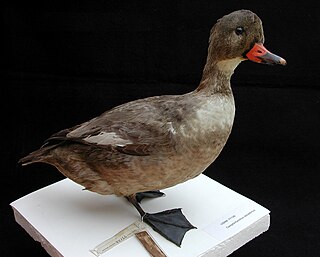
The Labrador duck is an extinct North American duck. It has the distinction of being the first known endemic North American bird species to become extinct after the Columbian Exchange, with the last known sighting occurring in 1878 in Elmira, New York. It was already a rare duck before European settlers arrived, and as a result of its rarity, information on the Labrador duck is not abundant, although some, such as its habitat, characteristics, dietary habits and reasons behind its extinction, are known. There are 55 specimens of the Labrador duck preserved in museum collections worldwide.
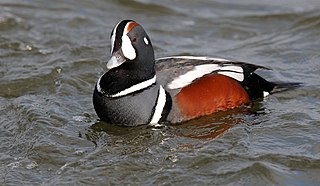
The sea ducks (Mergini) are a tribe of the duck subfamily of birds, the Anatinae. The taxonomy of this group is incomplete. Some authorities separate the group as a subfamily, while others remove some genera. Most species within the group spend their winters near coastal waters. Many species have developed specialized salt glands to allow them to tolerate salt water, but these are poorly developed in juveniles. Some of the species prefer riverine habitats. All but two of the 22 species in this group live in far northern latitudes.

Bachman's warbler is an extinct passerine migratory bird. This warbler was a migrant, breeding in swampy blackberry and cane thickets of the Southeastern and Midwestern United States and wintering in Cuba. There are some reports of the bird from the twenty-first century, but none are widely accepted. Some authorities accept a Louisiana sighting in August 1988 as confirmed, but the last uncontroversial sightings date to the 1960s.

The American white ibis is a species of bird in the ibis family, Threskiornithidae. It is found from Virginia via the Gulf Coast of the United States south through most of the coastal New World tropics. This particular ibis is a medium-sized bird with an overall white plumage, bright red-orange down-curved bill and long legs, and black wing tips that are usually only visible in flight. Males are larger and have longer bills than females. The breeding range runs along the Gulf and Atlantic Coast, and the coasts of Mexico and Central America. Outside the breeding period, the range extends further inland in North America and also includes the Caribbean. It is also found along the northwestern South American coastline in Colombia and Venezuela. Populations in central Venezuela overlap and interbreed with the scarlet ibis. The two have been classified by some authorities as a single species.
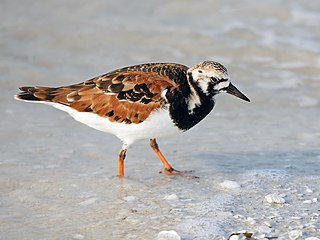
The ruddy turnstone is a small cosmopolitan wading bird, one of two species of turnstone in the genus Arenaria.
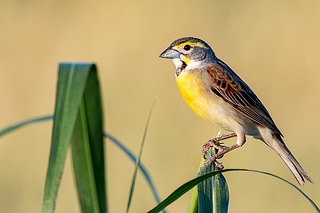
Cardinalidae is a family of New World-endemic passerine birds that consists of cardinals, grosbeaks, and buntings. It also includes several other genera such as the tanager-like Piranga and the warbler-like Granatellus. Membership of this family is not easily defined by a single or even a set of physical characteristics, but instead by molecular work. Among songbirds, they range from average-sized to relatively large, and have stout features, some species with large, heavy bills.

The harlequin duck is a small sea duck. It takes its name from Harlequin, a colourfully dressed character in Commedia dell'arte. The species name comes from the Latin word "histrio", meaning "actor". In North America it is also known as lords and ladies. Other names include painted duck, totem pole duck, rock duck, glacier duck, mountain duck, white-eyed diver, squeaker and blue streak.
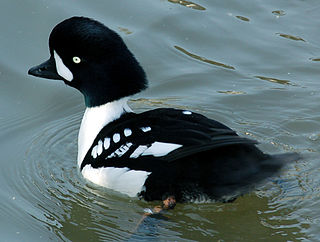
Barrow's goldeneye is a medium-sized sea duck of the genus Bucephala, the goldeneyes. This bird was named after Sir John Barrow. The genus name is derived from Ancient Greek boukephalos, "bullheaded", from bous, "bull" and kephale, "head", a reference to the bulbous head shape of the bufflehead. The species name islandica means Iceland.

The Pacific golden plover is a migratory shorebird that breeds during Alaska and Siberia summers. During nonbreeding season, this medium-sized plover migrates widely across the Pacific.

The red knot or just knot is a medium-sized shorebird which breeds in tundra and the Arctic Cordillera in the far north of Canada, Europe, and Russia. It is a large member of the Calidris sandpipers, second only to the great knot. Six subspecies are recognised.

The long-billed dowitcher is a medium-sized shorebird with a relatively long bill belonging to the sandpiper family, Scolopacidae. In breeding plumage, adults are characterized by a beautiful rufous head and underparts with a darker mottled back and a large white upper rump only seen in flight. They feed in various freshwater habitats with their bill underwater in a "sewing machine" motion and are known to have an exciting mating display where males chase females in flight. The genus, Limnodromus is Ancient Greek from limne, "marsh" and dromos, "racer". The specific scolopaceus is Neo-Latin for "snipe-like", from Latin scolopax, scolopacis, a snipe or woodcock. The English name is from Iroquois and was first recorded in 1841.
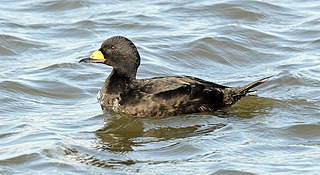
The black scoter or American scoter is a large sea duck, 43 to 49 cm in length. The genus name is derived from Ancient Greek melas "black" and netta "duck". The species name is from the Latin for "American ".

The white-winged scoter is a large sea duck. The genus name is derived from Ancient Greek melas "black" and netta "duck". The species name commemorates French ornithologist Côme-Damien Degland.

The king eider is a large sea duck that breeds along Northern Hemisphere Arctic coasts of northeast Europe, North America and Asia. The birds spend most of the year in coastal marine ecosystems at high latitudes, and migrate to Arctic tundra to breed in June and July. They lay four to seven eggs in a scrape on the ground lined with grass and down.
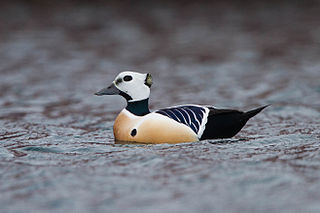
Steller's eider is a migrating Arctic diving duck that breeds along the coastlines of eastern Russia and Alaska. It is the rarest, smallest, and fastest flying of the eider species.

The common nighthawk or bullbat is a medium-sized crepuscular or nocturnal bird of the Americas within the nightjar (Caprimulgidae) family, whose presence and identity are best revealed by its vocalization. Typically dark, displaying cryptic colouration and intricate patterns, this bird is difficult to spot with the naked eye during the day. This bird is most conspicuous when in its buoyant and erratic flight. The most remarkable feature of this aerial insectivore is its small beak that belies the massiveness of its mouth. Some claim appearance similarities to owls. With its horizontal stance and short legs, the common nighthawk does not travel frequently on the ground, instead preferring to perch horizontally, parallel to branches, on posts, on the ground or on a roof. The males of this species may roost together but the bird is primarily solitary. The common nighthawk shows variability in territory size.

The flying steamer duck, also known as the flying steamer-duck or flying steamerduck, is a species of South American duck in the family Anatidae.

The eastern rockhopper penguin is a crested penguin with yellow crest feathers. It is a subspecies of the southern rockhopper penguin found in subantarctic regions and the Indian Ocean. It is one of the smallest crested penguins and has distinctive pink margins around its bill.

The least flycatcher is a small insect-eating bird. It is the smallest Empidonax flycatcher in eastern North America.

The eastern cattle egret is a species of heron found in the tropics, subtropics and warm temperate zones. Most taxonomic authorities lump this species and the western cattle egret together as subspecies of the cattle egret, but some separate them. Despite the similarities in plumage to the egrets of the genus Egretta, it is more closely related to the herons of Ardea. It is native to southern and eastern Asia, and Australasia.























